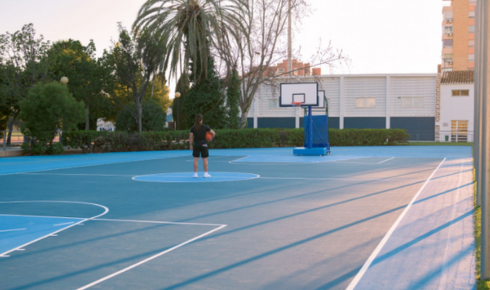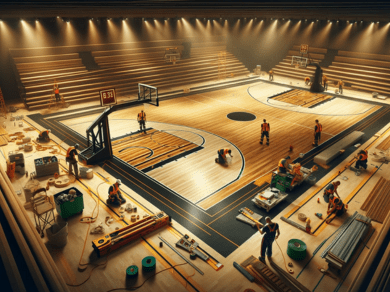Synthetic Flooring for Basketball Courts: Pros & Cons

When it comes to building a basketball court, few decisions are as critical as selecting the right surface. The flooring not only determines the quality of play but also impacts safety, durability, maintenance, and overall cost. With innovations in construction materials, synthetic basketball court flooring has emerged as a popular and practical choice—especially for outdoor courts in India.
But is synthetic flooring right for your basketball facility? In this post, we’ll explore the pros and cons of synthetic basketball court flooring, with a special focus on acrylic basketball court surfaces. Whether you’re planning a school court, a society play area, or a professional sports complex, understanding the surface dynamics will help you make an informed decision.
Understanding the Role of Basketball Court Flooring
Basketball is a sport that demands rapid lateral movement, consistent bounce, and strong traction. The flooring must support intense footwork, absorb impact, and resist abrasion caused by regular use. At the same time, it should ensure safety for players, preventing slips and joint injuries.
Traditionally, wooden surfaces were the standard for indoor courts. But for outdoor settings and budget-conscious projects, synthetic basketball court flooring—especially acrylic-based systems—has become the preferred alternative.
In India, where outdoor exposure to heat, rain, and dust is common, synthetic flooring offers weatherproof performance while keeping maintenance costs low.
What Is Synthetic Basketball Flooring?
Synthetic flooring refers to man-made, multi-layered surface systems made from materials like acrylic, polyurethane (PU), or modular polypropylene (PP) tiles. These systems are applied over a solid base such as concrete or asphalt, creating a seamless and safe outdoor basketball court surface.
Among these, acrylic basketball court systems stand out for their balance between performance and affordability. These are composed of primer coats, cushion layers (optional), and top color coats that resist UV rays and water damage.
Pros of Synthetic Basketball Court Flooring
Let’s take a closer look at why synthetic flooring—especially acrylic systems—is a leading choice for basketball court flooring in India:
All-Weather Durability
Indian outdoor courts must withstand intense sunlight in summer and heavy rain during monsoon. Acrylic coatings are designed to be UV-resistant and water-repellent, making them ideal for exposed settings. Unlike wood, which can warp, or tiles, which may shift, acrylic floors remain stable throughout the year.
Non-Slip, Safe Surface
Safety is a top priority in basketball. Acrylic courts provide a textured finish that prevents slipping, even in damp conditions. Optional cushion layers offer shock absorption, reducing stress on players’ knees and ankles—especially important for youth and senior players.
Low Maintenance
Synthetic basketball flooring requires far less maintenance than wooden courts or interlocking tiles. There’s no need for regular polishing or sanding. Basic cleaning and occasional repainting keep the surface in excellent shape, making it ideal for schools, clubs, and community courts.
Customization Options
Acrylic systems allow for full customization of court colors, logos, and line markings. This helps in creating visually appealing courts that reflect a school’s or club’s branding, improving overall facility value.
Long-Term Cost Efficiency
Though the initial cost of installing synthetic flooring might seem higher than concrete, it pays off over time. With reduced maintenance, longer surface life, and minimal repairs, synthetic systems prove to be more economical in the long run.
Cons of Synthetic Basketball Flooring
While synthetic acrylic flooring offers numerous advantages, it’s important to be aware of its limitations to make a well-rounded decision.
Not Ideal for Indoor Use
Acrylic-based flooring is designed mainly for outdoor use. For indoor basketball courts, wood or polyurethane flooring is still considered superior in terms of bounce and comfort. Acrylic surfaces may feel hard underfoot in enclosed environments and may lack the cushioned response expected in professional indoor settings.
Installation Requires Skilled Labor
Installing synthetic systems—especially multi-layer acrylic ones—requires precision and experience. Any flaws in the base or application process can result in uneven surfaces, pooling, or premature wear. Therefore, it’s essential to hire experienced sports flooring contractors.
Surface Heating in Extreme Sunlight
On extremely hot days, acrylic surfaces can become warm underfoot. While they don’t deform or fade, this heat may affect user comfort during midday play. Proper shading or scheduling games in the morning or evening can help mitigate this.
Acrylic vs. Other Synthetic Flooring Options
While acrylic is the leading option for outdoor basketball court flooring, let’s briefly compare it to other synthetic alternatives:
- Polyurethane (PU): Excellent for indoor courts due to its softness and shock absorption. However, it lacks UV resistance, making it unsuitable for outdoor basketball flooring in India.
- Modular PP Tiles: These offer portability and water drainage features. But they may cause uneven ball bounce and are less comfortable for fast-paced games due to their rigid structure.
In most outdoor projects, acrylic emerges as the best all-rounder—offering consistent ball bounce, grip, and weather resistance at a reasonable cost.
Applications Across India
In recent years, schools, sports academies, government parks, and private developers have increasingly opted for acrylic basketball court installations. The reasons are clear:
- Safe for students and community users
- Easy to clean and repair
- Professional appearance with customizable layouts
- Can be combined with other multi-sport flooring systems
These surfaces are now a regular feature in modern urban infrastructure, fulfilling both recreational and professional needs.
Choosing a Reliable Flooring Partner
To make the most of synthetic basketball flooring, working with a reliable supplier is crucial. Look for companies that offer:
- Certified acrylic materials
- UV- and weather-tested products
- Custom line marking and color options
- On-site technical support
- Experience in sports surface installation
AQS is one of India’s most trusted suppliers of synthetic sports flooring. Their acrylic basketball court systems are engineered specifically for Indian conditions, ensuring a safe, durable, and high-performance surface for players at every level.
Conclusion
Synthetic basketball flooring is a game-changer for outdoor courts in India. From its weather resistance to its low-maintenance benefits, it offers a professional and safe playing experience. While it may not be the go-to choice for indoor courts, it dominates outdoor setups with its reliability and customization flexibility.
For schools, sports clubs, urban developers, and community planners, acrylic basketball court flooring presents an ideal blend of function, aesthetics, and value. With the right installation team and certified materials, your court can deliver years of performance—without breaking the bank.
Looking to build a long-lasting basketball court? Explore acrylic flooring solutions with AQS—India’s expert in synthetic sports surfaces.
